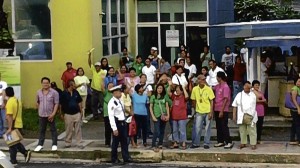Slum dwellers gain land in QC auction

MEMBERS of the Sta. Maria Della Strada Cooperative emerge victorious from the property auction held at Quezon City Hall on Oct. 4. Contributed photo/Norberto Nazareno
Muted tension filled the room when Item No. 93 was announced at the auction of tax-defaulted properties in Quezon City on Thursday last week. Up for bidding was a parcel of land in Barangay Pansol.
Unknown to many, a group of informal settlers backed by a parish-based cooperative was awaiting the results with bated breath, pinning its hopes on the 1,200-square-meter lot.
Down the stretch, it all came down to three bidders—three hands holding up numbered bidding paddles—until the highest offer reached P700,000.
“Gone! Sold to bidder No. 24!” the auctioneer declared as the small crowd burst into applause.
For the leaders of Sta. Maria Della Strada Cooperative (SMDSC), the Oct. 4 auction marked the first crucial step in their mission to secure land titles for longtime squatters among its members.
The cooperative along with its partner, the Pangkat Ugnayan sa Paninirahan (PUSP) homeowners association, won the rights to the lot which was part of a 3.3-hectare property in Kaingin 2, a compound that has been occupied by hundreds of informal settlers for over half a century.
It was a triumph of a rare sort for Metro Manila’s urban poor, who often have to beg, bleed, and battle it out with the government and private sector just to secure a land of their own.
“We were all very happy… The auction was quite an experience for us,” said SMDSC chair Norberto Nazareno, a former banker and finance officer.
Dozens of Kaingin 2 residents came by the busloads to give moral support, and later let out a big cheer as the group marched victorious out of a LandBank branch inside City Hall where the auction was held.
PUSP president Jose Evilla said he could not possibly ask for a better outcome. “The other bidders probably didn’t know that there were informal settlers in that area so the price kept going up. There’s nothing we could do about that. But we’re glad of the result,” he told the Inquirer.
Evilla said he considered it a blessing that private-sector groups like SMDSC had come forward to help them when many informal settlements in Metro Manila had been targeted for demolition.
“This gives us some peace of mind about our future,” he said.
Once the property is transferred to SMDSC, it will be distributed to some 30 families who will each pay P25,000 over 20 years at a mere 1-percent interest, according to Socorro “Corito” Llamas, a writer who sits in the board of the cooperative’s social action unit.
The acquisition of the property is only the beginning, Llamas said, since up to 28 more lots in Kaingin 2 must be bought by the cooperative if the target is to cover the more than 1,000 informal settlers in the area.
City Hall is expected to auction off the other lots whose registered owners have not been paying taxes—an opportunity which the cooperative also hopes to seize.
“We learned (during the Oct. 4 auction) that there are many parties interested in the area. We should then expect more challenges concerning the other lots,” said Nazareno, former president of Philippine Banking Corp. and Philippine Deposit Insurance Corp.
There is also an internal issue that has to be hurdled concerning the land distribution. Within Kaingin 2 is a core group of 1,300 longtime residents—but newcomers numbering about 500 have added to the population in recent years.
“So we have to set first, second and third priorities as to who will be given titles,” said Evilla, stressing that PUSP would be there to resolve any conflict.
The 3.3-hectare Kaingin property, which is bordered by the upscale La Vista subdivision and the University of the Philippines-Integrated School campus, was once owned by the late Antonio Tuason and later bought by Loyola Grand Villas in the 1970s. It was later divided into smaller parcels and acquired by different buyers.
Abandoned properties
But many of these owners later abandoned their properties without paying taxes because of the growing encroachment of squatters, Llamas said.
The Quezon City government auctioned off one of the lots, particularly the property fronting Katipunan Avenue which has attracted not a few real-estate prospectors because of its prime location.
Nazareno’s initial computations pegged the value of the property at P571 per square meter, but data gathered prior to the recent bidding showed that adjacent properties could fetch as much as P30,000 per square meter.
SMDSC’s only interest in acquiring the property was to secure land titles for members who are longtime squatters, Nazareno stressed.
Of the coop’s 6,500 members, mostly drawn from Barangay Loyola Heights and Pansol, about 20 percent may be classified as informal settlers.
SMDSC was organized in May 1996 by 15 people who contributed P2,000 each. They included the then parish priest, Msgr. Patricio H. Lim, and prominent parishioners like Vicente Jayme, Floy Aguenza, Ben Casino, Primitiva Nisperos and Norberto Fortaleza.
It obtained a license as a multipurpose cooperative, but the board of directors felt it best to work as a credit cooperative to avoid being in competition with the business interests of its members.
“It thus served as an effective microfinance facility that has helped many members from the low-income areas,” Llamas said.
From its starting capital of P30,000, the cooperative’s assets have grown to P98 million under the leadership of Nazareno and of another former banker, Flordeliz Aguenza, past president of Planters Development Bank.
The cooperative can now afford to offer more social action packages to its members, like health and social security insurance, among other things. The family of a deceased member, for example, can receive up to P150,000 in benefits.
All these, plus the unprecedented opportunity to acquire land for the landless in an exciting, competitive fashion, as shown during the Oct. 4 bidding.